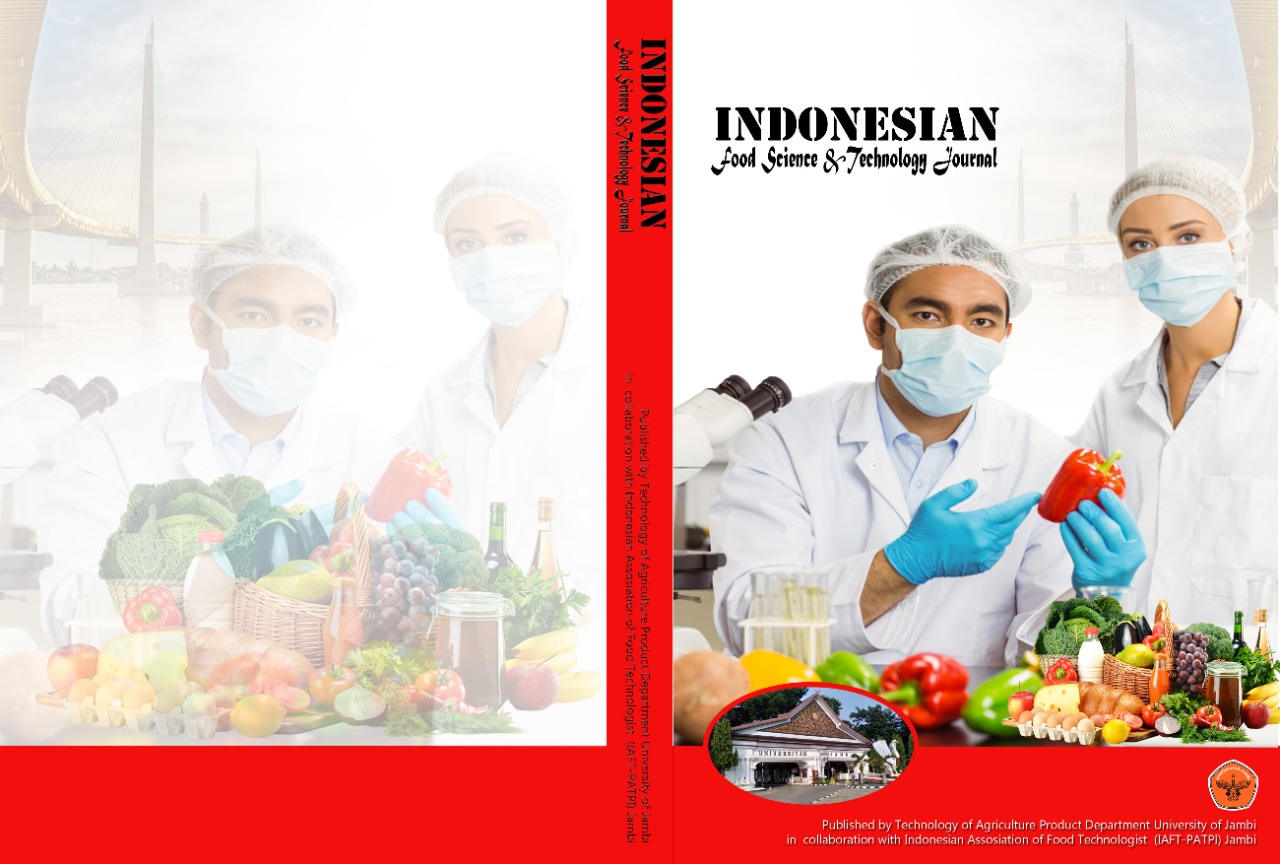A Nutritional, Physicochemical, and Sensory Evaluation of Tempe Combination from Cowpea and Soybean
DOI:
https://doi.org/10.22437/ifstj.v8i1.36386Keywords:
Cowpea, design expert, formula optimization, soybean,, tempeAbstract
Tempe is a traditional Indonesian food typically made from soybeans fermented by the mold Rhizopus spp. Indonesia heavily relies on imported soybeans, and substituting soybeans with cowpea (Vigna unguiculata) could reduce this dependency while promoting local raw materials. This study aimed to develop an optimal tempe formula combining cowpea and soybean, ensuring quality parameters comparable to conventional soybean tempe (the gold standard). Formula optimization was conducted using response surface methodology, facilitated by Design Expert 12 software. The recommended optimal formula consists of 30% cowpea and 70% soybean, achieving a desirability value of 0.87. This formulation resulted in tempe with L* (brightness), a* (red-green), b* (yellow-blue), hardness, water activity, and pH values that were not significantly different from those of soybean tempe. The proximate composition of the optimally formulated tempe complies with the quality standards of SNI 3144:2015, with moisture, ash, fat, protein, and carbohydrate contents of 60.28, 0.64, 10.28, 17.67, and 11.67% respectively. Sensory evaluation using a 1-7 hedonic scale (ranging from "very dislike" to "very like") on fresh and fried tempe from the optimal combination indicates that attributes such as color, aroma, texture, and overall acceptability fall within the range of "somewhat liked" to "like" by consumers. The favorable reception of the soybean-cowpea tempe suggests its potential for reducing soybean imports by substituting 30% of the soybean with cowpea.
Downloads
References
[1] D. Rahmawati, M. Astawan, S. P. Putri, and E. Fukusaki, “Gas chromatography-mass spectrometry-based metabolite profiling and sensory profile of Indonesian fermented food (tempe) from various legumes,” J Biosci Bioeng, vol. 132, no. 5, 2021, doi: 10.1016/j.jbiosc.2021.07.001.
[2] BPS, “Rata-Rata Konsumsi Per Kapita Seminggu Beberapa Macam Bahan Makanan Penting,” Jakarta, 2021.
[3] Kementan, “Berita Resmi PVT Pendaftaran Varietas Hasil Pemuliaan: Kacang Tunggak Albina IPB,” Jakarta, 2020.
[4] C. Jayathilake et al., “Cowpea: an overview on its nutritional facts and health benefits,” J Sci Food Agric, vol. 98, no. 13, pp. 4793–4806, Oct. 2018, doi: 10.1002/JSFA.9074.
[5] P. Ogun, P. Markakis, and W. Chenoweth, “Effect of Processing on Certain Antinutrients in Cowpeas (Vigna unguiculata),” J Food Sci, vol. 54, no. 4, pp. 1084–1085, Jul. 1989, doi: 10.1111/J.1365-2621.1989.TB07952.X.
[6] W. Prinyawiwatkul, L. R. Beuchat, K. H. McWatters, and R. D. Phillips, “Fermented Cowpea Flour: Production and Characterization of Selected Physico-chemical Properties,” J Food Process Preserv, vol. 20, no. 4, pp. 265–284, Aug. 1996, doi: 10.1111/J.1745-4549.1996.TB00747.X.
[7] C. B. Devi, A. Kushwaha, and A. Kumar, “Sprouting characteristics and associated changes in nutritional composition of cowpea (Vigna unguiculata),” J Food Sci Technol, vol. 52, no. 10, pp. 6821–6827, Oct. 2015, doi: 10.1007/S13197-015-1832-1/METRICS.
[8] N. Wang, M. J. Lewis, J. G. Brennan, and A. Westby, “Optimization of germination process of cowpea by response surface methodology,” Food Chem, vol. 58, no. 4, pp. 329–339, Apr. 1997, doi: 10.1016/S0308-8146(96)00200-2.
[9] I. S. Rahmawati et al., “Effect of Fermentation Time on Mineral Profile and Total Mold of Cowpea (Vigna unguiculata) Tempeh,” Jurnal Pangan dan Agroindustri, vol. 11, no. 4, pp. 178–185, Oct. 2023, doi: 10.21776/UB.JPA.2023.011.04.2.
[10] H. Adhianata, A. Pramana, N. Rochmawati, and Y. Ditya, “Development of Non-Soybean Tempeh from Cowpea Bean and Koro Bean,” IOP Conf Ser Earth Environ Sci, vol. 1059, no. 1, p. 012062, Jul. 2022, doi: 10.1088/1755-1315/1059/1/012062.
[11] M. Astawan, T. Wresdiyati, R. M. Yoshari, N. A. Rachmawati, and R. Fadilla, “The Physicochemical Properties of Tempe Protein Isolated from Germinated and Non-Germinated Soybeans,” J Nutr Sci Vitaminol (Tokyo), vol. 66, no. Supplement, pp. S215–S221, 2020, doi: 10.3177/JNSV.66.S215.
[12] A. D. Kadar, M. Astawan, S. P. Putri, and E. Fukusaki, “Metabolomics based study of the effect of raw materials to the end product of tempe—an indonesian fermented soybean,” Metabolites, vol. 10, no. 9, 2020, doi: 10.3390/metabo10090367.
[13] BSN, Tempe: Persembahan Indonesia untuk Dunia. Jakarta: Badan Standardisasi Nasional, 2012. [Online]. Available: www.bsn.go.id
[14] M. Astawan, A. P. G. Prayudani, M. Haekal, T. Wresdiyati, and R. E. Sardjono, “Germination effects on the physicochemical properties and sensory profiles of velvet bean (Mucuna pruriens) and soybean tempe,” Front Nutr, vol. 11, 2024, doi: 10.3389/FNUT.2024.1383841.
[15] D. Montgomery, Design and Analysis of Experiments 9th Edition. New York (US): John Willey and Sons Inc, 2017.
[16] M. Duweini and R. Trihaditia, “Penentuan formulasi optimum pembuatan minuman fungsional dari bunga rosella (Hibiscus sabdariffa L.) Dengan penambahan bawang dayak (Eeutherine palmifolia (L) Merr.) menggunakan metode RSM (response surface method),” Agroscience, vol. 7, no. 2, pp. 234–247, 2017.
[17] I. O. Owolabi et al., “Packaging and packaging technology for indigenous fermented foods in the tropics: challenges and opportunities,” Indigenous Fermented Foods for the Tropics, pp. 563–575, Jan. 2023, doi: 10.1016/B978-0-323-98341-9.00022-0.
[18] S. A. Mahdi, M. Astawan, N. Wulandari, T. Muhandri, T. Wresdiyati, and A. E. Febrinda, “Formula Optimization and Physicochemical Characterization of Tempe Drink Powder,” Current Research in Nutrition and Food Science, vol. 10, no. 3, pp. 1178–1195, Dec. 2022, doi: 10.12944/CRNFSJ.10.3.31.
[19] J. Mugendi, E. Njagi, E. Kuria, and M. Mwasaru, “Nutritional quality and physicochemical properties of Mucuna bean (Mucuna pruriens L.) protein isolates,” Int Food Res J, vol. 17, pp. 357–366, 2010, Accessed: Aug. 09, 2021. [Online]. Available: http://repository.mut.ac.ke/handle/123456789/2742
[20] A. Anton and F. Luciano, “Instrumental texture evaluation of extruded snack foods: A review,” CYTA - Journal of Food, vol. 5, no. 4, pp. 245–251, 2007, doi: 10.1080/11358120709487697.
[21] AOAC, Official Method of Analysis Association of Official Analytical Chemistry, 19th ed. Gaithersburg: The AOAC, inc, 2012.
[22] V. Dolganyuk et al., “Food Proteins: Potential Resources,” Sustainability 2023, Vol. 15, Page 5863, vol. 15, no. 7, p. 5863, Mar. 2023, doi: 10.3390/SU15075863.
[23] M. Prabudi et al., “Aplikasi Response Surface Methodology (RSM) dengan Historical Data pada Optimasi Proses Produksi Burger,” Jurnal Mutu Pangan : Indonesian Journal of Food Quality, vol. 5, no. 2, pp. 109–115, Oct. 2018, Accessed: Jun. 24, 2024. [Online]. Available: https://journal.ipb.ac.id/index.php/jmpi/article/view/26230
[24] S. Raissi and R.-E. Farsani, “Statistical Process Optimization Through Multi-Response Surface Methodology,” International Journal of Mathematical and Computational Sciences, vol. 3, no. 3, pp. 197–201, Mar. 2009, doi: 10.5281/ZENODO.1083451.
[25] G. A. Annor et al., “Response surface methodology for studying the quality characteristics of cowpea (Vigna unguiculata)-based tempeh,” J Food Process Eng, vol. 33, no. 4, pp. 606–625, Aug. 2010, doi: 10.1111/J.1745-4530.2008.00292.X.
[26] J. Gu et al., “Impact of processing and storage on protein digestibility and bioavailability of legumes,” Food Reviews International, vol. 39, no. 7, pp. 4697–4724, Aug. 2023, doi: 10.1080/87559129.2022.2039690.
[27] B. S. Gebregziabher et al., “Origin, Maturity Group and Seed Coat Color Influence Carotenoid and Chlorophyll Concentrations in Soybean Seeds,” Plants, vol. 11, no. 7, p. 848, Apr. 2022, doi: 10.3390/PLANTS11070848/S1.
[28] C. E. Chinma, J. O. Abu, S. James, and M. Iheanacho, “Chemical, Functional and Pasting Properties of Defatted Starches from Cowpea and Soybean and Application in Stiff Porridge Preparation,” Nigerian Food Journal, vol. 30, no. 2, pp. 80–88, Jan. 2012, doi: 10.1016/S0189-7241(15)30039-4.
[29] S. Mandliya, A. Pratap-Singh, S. Vishwakarma, C. G. Dalbhagat, and H. N. Mishra, “Incorporation of Mycelium (Pleurotus eryngii) in Pea Protein Based Low Moisture Meat Analogue: Effect on Its Physicochemical, Rehydration and Structural Properties,” Foods, vol. 11, no. 16, p. 2476, Aug. 2022, doi: 10.3390/FOODS11162476/S1.
[30] S. B. Erkan, H. N. Gürler, D. G. Bilgin, M. Germec, and I. Turhan, “Production and characterization of tempehs from different sources of legume by Rhizopus oligosporus,” LWT, vol. 119, p. 108880, Feb. 2020, doi: 10.1016/J.LWT.2019.108880.
[31] M. S. Tapía, S. M. Alzamora, and J. Chirife, “Effects of Water Activity (a w ) on Microbial Stability as a Hurdle in Food Preservation,” Water Activity in Foods: Fundamentals and Applications, pp. 323–355, Jan. 2020, doi: 10.1002/9781118765982.CH14.
[32] S. Mahdi, M. Astawan, N. Wulandari, and T. Muhandri, “Sensory profiling of tempe functional drink powder using rate-all-that-apply method,” Food Res, vol. 7, pp. 19–26, 2023, doi: 10.26656/fr.2017.7(S2).3.
[33] Z. Abdurrasyid, M. Astawan, H. N. Lioe, and T. Wresdiyati, “Physicochemical and Antioxidant Properties of Germinated Soybean Tempe after Two Days Additional Fermentation Time,” Biointerface Res Appl Chem, vol. 13, no. 3, pp. 238–252, 2023, doi: 10.33263/BRIAC133.238.
[34] Z. Abdurrasyid, M. Astawan, H. N. Lioe, and T. Wresdiyati, “Evaluation of hypoglycaemic potency in tempe with soybean germination process and extended fermentation time,” Food Res, vol. 7, pp. 217–227, 2023, doi: 10.26656/fr.2017.7(S1).32.
[35] D. Muzdalifah, Z. Athaillah, W. Nugrahani, and A. Devi, “Colour and pH changes of tempe during extended fermentation,” in AIP Conference Proceedings, 2017, p. 1803(1): 020036. doi: doi:10.1063/1.4973163.
[36] M. Egounlety and O. C. Aworh, “Effect of soaking, dehulling, cooking and fermentation with Rhizopus oligosporus on the oligosaccharides, trypsin inhibitor, phytic acid and tannins of soybean (Glycine max Merr.), cowpea (Vigna unguiculata L. Walp) and groundbean (Macrotyloma geocarpa Harms),” J Food Eng, vol. 56, no. 2–3, pp. 249–254, Feb. 2003, doi: 10.1016/S0260-8774(02)00262-5.
[37] Ratnaningsih, E. Ginting, M. Adie, and D. Harnowo, “Sifat fisikokimia dan kandungan serat pangan galur-galur harapan kedelai.,” Jurnal Penelitian Pascapanen Pertanian, vol. 14, no. 1, pp. 35–45, 2017.
[38] R. L. Karuwal, Suharsono, A. Tjahjoleksono, and N. Hanif, “Short Communication: Characterization and nutrient analysis of seed of local cowpea (Vigna unguiculata) varieties from Southwest Maluku, Indonesia,” Biodiversitas, vol. 22, no. 1, pp. 85–91, Jan. 2021, doi: 10.13057/BIODIV/D220112.
[39] T. Wresdiyati, A. Firdaus, and M. Astawan, “Tempe and soybean var. Grobogan-indonesia increasedthe number of osteoblasts and osteocytes, inhibited osteoclast damage inthe tibia bone of rats,” Hayati, vol. 28, no. 2, 2021, doi: 10.4308/hjb.28.2.144.
[40] R. Mulyowidarso, G. Fleet, and K. Buckle, “Changes in the concentration of carbohydrates during the soaking of soybeans for tempe production,” Int J Food Sci Technol, vol. 26, no. 6, pp. 595–606, Dec. 1991, doi: 10.1111/J.1365-2621.1991.TB02005.X.
[41] M. Astawan, T. Wresdiyati, and L. Maknun, Tempe: Sumber Zat Gizi dan Komponen Bioaktif untuk Kesehatan. Bogor: IPB Press, 2017.
[42] H. Jeleń, M. Majcher, A. Ginja, and M. Kuligowski, “Determination of compounds responsible for tempeh aroma,” Food Chem, vol. 141, no. 1, pp. 459–465, Nov. 2013, doi: 10.1016/J.Foodchem.2013.03.047.
[43] M. Astawan, A. P. G. Prayudani, P. Hadiningtias, T. Wresdiyati, and Andi Early Febrinda, “Effect of tea extract (Camellia sinensis) on shelf life and intrinsic quality of tempe”, Canrea, vol. 7, no. 1, pp. 1–14, Jun. 2024. https://doi.org/10.20956/canrea.v7i1.1023
Downloads
Published
How to Cite
Issue
Section
License
Copyright (c) 2024 Indonesian Food Science and Technology Journal

This work is licensed under a Creative Commons Attribution 4.0 International License.








